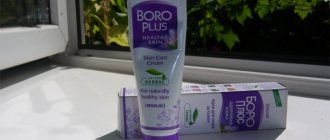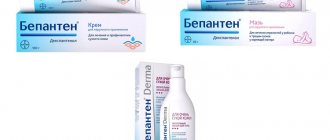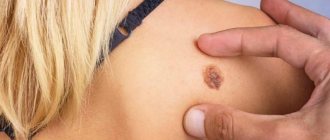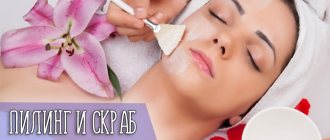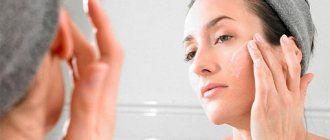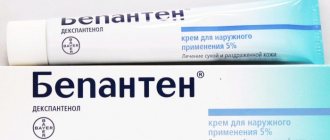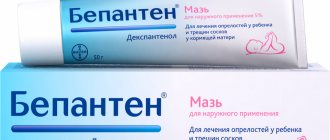Bepanten or Bepanten Plus - this choice may arise if you need to purchase a product that stimulates skin regeneration. These drugs are produced by the German pharmaceutical company Bayer. They belong to the same line, but have some differences.
Bepanten and Bepanten Plus are drugs that stimulate skin regeneration.
Compound similarities
Both drugs contain 5% dexpanthenol. It is easily absorbed by the epidermis and converted into pantothenic acid. Rapid penetration into all layers of the skin occurs due to the molecular weight, hydrophilicity and low polarity of dexpanthenol. In the form of coenzyme A, it takes an active part in metabolism at the cellular level, enhancing acetylation processes.
Pantothenic acid is a water-soluble B vitamin that is part of coenzyme A and forms bonds with plasma proteins (albumin and beta globulin). As part of coenzyme A, dexpanthenol affects fat and carbohydrate metabolism, promotes the formation of porphyrins, acetylcholine and corticosteroids. This happens:
- rapid restoration of skin and mucous membranes;
- normalization of metabolism in cells;
- stimulation of fibroblast division;
- reduction of swelling;
- moisturizing the epidermis.
- increasing the strength of collagen fibers.
The excipients of these drugs are identical.
Bepanten contains only one active substance - dexpanthenol (5%) - and is approved for the treatment of newborns.
These medications are used for superficial skin lesions, such as:
- sun, thermal or chemical burns;
- mechanical abrasions or cuts;
- dry skin;
- dermatitis;
- protection of the face and hands from wind and cold;
- cracks in the nipples during lactation;
- anal fissures;
- diaper rash or diaper dermatitis;
- boils, trophic ulcers;
- skin grafting;
- cervical erosion;
- bedsores.
Bepanten
The active ingredient of the drug is dexpanthenol , which is well absorbed and then transformed into pantothenic acid. The latter, in turn, normalizes cellular metabolism, includes mitosis, and strengthens collagen bonds. The medicine moisturizes, restores, and anesthetizes the skin. It can be applied to any area, including wet and open wounds, and the scalp.
The medication is available in tubes or bottles in the form of a cream, ointment or lightweight lotion, varying in consistency. It is recommended for use in the following cases:
- To restore the skin of infants.
- For the prevention of prickly heat, diaper rash, dermatitis.
- To protect nipples from cracks during feeding.
- After sun or chemical burns.
- In the presence of necrosis, ulcers, fissures of the anus.
- After skin grafting.
- After insect bites.
- After visiting the pool, etc.
In general, the product has no adverse reactions, with the exception of allergies, which manifest themselves in the form of a rash or hives. In this case, the drug is discontinued.
It must be spread in a thin layer. In the presence of deep wounds, the treatment is repeated several times a day. The pharmaceutical drug does not interact with other medications. It is stored at room temperature for 3 years. The average cost is 500 rubles .
Differences between Bepanten and Bepanten Plus
Bepanthen contains only one active substance - dexpanthenol (5%) - and is approved for the treatment of newborns. Bepanthen Plus, in addition to the main active ingredient, contains an antiseptic - chlorhexidine dihydrochloride (0.5%), which is not recommended for use in children under 1 year of age.
Chlorhexidine dihydrochloride is well tolerated and has a bactericidal effect on gram-positive bacteria. The main purpose of adding this substance to the composition is to destroy Staphylococcus aureus, which causes skin infections. There is a decrease in the effectiveness of chlorhexidine dihydrochloride against gram-negative bacteria and fungi. This substance has no effect on viruses.
Bepanten Plus is used in the treatment of superficial skin lesions if there is a risk of infection. After surgical interventions, the use of an antiseptic form of the drug is also recommended.
Bepanten has 2 release forms - ointment and cream, and the antiseptic version of the drug is available only in the form of a cream.
Special instructions for the use of the drug Bepanten plus
Avoid contact of the drug with the eyes. Bepanten Plus is not recommended for use on skin irritations with a low risk of infection (for example, sunburn). In these cases, it is recommended to use Bepanten cream or Bepanthen lotion. Use during pregnancy and lactation. Reproductive function studies in animals did not reveal any risk to embryos. Bepanten Plus should not be used on large areas of the skin, since there is no data on the use of the drug in controlled studies in women during pregnancy. The drug can be used by women during breastfeeding, but not applied during feeding (before feeding a baby, remove the remaining cream with a napkin and wash the nipples with water). Children. The drug is used in children over 1 year of age. Impact on the ability to drive vehicles and work with complex mechanisms. Does not affect.
Contraindications
Both drugs cannot be used if hypersensitivity to dexpanthenol or to any other components of the drugs is diagnosed.
There is an additional contraindication for the use of Bepanthen Plus - intolerance to chlorhexidine dihydrochloride. Due to the presence of this substance in the composition, antiseptic cream should not be applied to a perforated eardrum. Antiseptic Bepanthen Plus is not used to treat children from birth to 1 year.
Bepanten Plus is used in the treatment of superficial skin lesions if there is a risk of infection.
Bepanten Plus
The action of the medication is based on two components - dexpanthenol and chlorhexine , the action of which is aimed not only at tissue restoration, but also at relieving painful symptoms and preventing decomposition processes. It is only available in cream form.
The drug is used for:
- Damage to the integrity of the skin.
- The occurrence of ulcers and necrosis.
- Skin infection.
- The appearance of cracks in the nipples, etc.
The cream is not recommended for use if there is a high sensitivity to the composition. In addition, it should not be applied to a damaged drum membrane.
The medication may cause allergies. In rare cases, applying the cream provokes anaphylactic shock, damage to the respiratory tract and heart muscle, and changes in the skin. It is not applied to large areas.
Bepanten Plus is prescribed from 1 year of age. It is spread as needed, but the highest daily dose should not exceed 5 g. In case of overdose, the aminotransferase content in the body increases. If necessary, the cream can be applied in the form of a gauze compress.
Due to the content of chlorhexine, the cream cannot be used in conjunction with saponifiers and anionic groups.
The medicine is stored at room temperature for 3 years. The average cost is 500 rubles .
Reviews from doctors
Robulets P. A., dermatologist: “Both drugs belong to the means of stimulating skin regeneration. They have a wide range of applications. I would like to note their effectiveness during the recovery period after skin transplantation surgery. Burns are also a common reason for using these products. Dexpanthenol is an excellent skin regenerating substance.”
Deineka B.I., obstetrician: “The Bepanthen® composition does not cause allergies, so the ointment is recommended for newborns. This drug is the only one that can be used to treat the nipples of the mammary glands when feeding a child. The series supplemented with hydrochloride is not suitable for this. But to treat minor abrasions, scuffs and scratches in children over one year old, you can also use the antiseptic version of the drug.”
What do they have in common?
Both drugs are similar in their release form and purpose.
They are intended for external use and have some analgesic and cooling effects. The action of the main component of creams, dexpanthenol, is aimed at normalizing epithelial metabolism and relieving inflammation.
The drugs are well absorbed and do not leave behind an oily sheen. They are spread in a thin layer on clean, disinfected skin and carefully distributed over the damaged area. Remove excess food with a napkin.
Patient reviews
Valentina, 23 years old, Saratov: “I came across this ointment for the first time when getting ready for the maternity hospital. It was one of the required items, along with diapers and nappies. When purchasing, I was very outraged by the price, because there are many inexpensive analogue creams with dexpanthenol on sale. But I didn’t dare take the initiative. The ointment turned out to be excellent - the child did not have any skin problems. She dealt with both dryness and diaper rash. I later tried to replace it with cheaper analogues, but returned to Bepanten because the result was worse.”
Marina, 35 years old, Rostov-on-Don: “I use Bepanten for cosmetic purposes. I use the cream as a daytime skin care product, and the ointment as a nighttime skin care product. The regenerating cream not only relieves irritation and inflammation, but also perfectly moisturizes the skin, making it elastic, young and fresh. There is nothing unnecessary or harmful in it.”
Price
| Drug name | Release form | Net weight, g | Average price, rub. |
| Bepanthen®, 5% dexpanthenol | ointment | 100 | 767 |
| 50 | 540 | ||
| 30 | 444 | ||
| cream | 100 | 740 | |
| 50 | 570 | ||
| 30 | 427 | ||
| Bepanten® plus, 5% dexpanthenol | cream | 100 | 717 |
| 30 | 437 |
The cost of these drugs depends on the form of release and the pricing policy of the pharmacy.
Bepanten Ointment for diaper rash and cracked nipples, 100 g, Bayer
Active substance:
1 g of ointment contains: dexpanthenol – 50 mg;.
Excipients:
Protegin X 50 mg, cetyl alcohol 18 mg, stearyl alcohol 12 mg, white beeswax 40 mg, lanolin 250 mg, soft white paraffin 130 mg, almond oil 50 mg, liquid paraffin 150 mg, purified water up to 1000 mg.
A soft, elastic, homogeneous, opaque ointment of pale yellow color with a faint odor of lanolin.
Description:
Bepanten Ointment for diaper rash and cracked nipples, 100 g.
Bepanten, the sales leader in the skin treatment and care category*, presents Bepanten ointment. Bepanten Ointment is a proven remedy* for the treatment of diaper rash in children and cracked nipples in nursing mothers.
The ingredients that make up Bepanten Ointment provide a double effect: - Provitamin B5 stimulates the healing of damaged skin *; — A high concentration of natural lanolin** allows the formation of a breathable layer on the skin, protecting it from repeated irritation.
Bepanten ointment is completely free of preservatives, dyes and flavors that tend to cause allergic reactions.
The favorable safety profile of the product allows it to be used even on the vulnerable skin of newborns.
More than 70 years of application experience around the world.
Numerous clinical studies.
*Bepanten from Bayer is the world's leading seller of over-the-counter skin care and treatment products based on Nicholas Hall's global DB6 OTC database, 2022, euros; Vasilevsky I.V. Optimization of skin care in newborns and infants // International reviews: clinical practice and health. - 2015. - No. 1. — p.5-18; In a comparative randomized study involving 62 newborns, none of the children who were prescribed Bepanten ointment for prophylactic purposes (n=40) developed diaper dermatitis during their hospital stay, and no adverse reactions were observed. Yatsyk G.V., Akoev Yu.S. Clinical effectiveness of various newborn skin care products based on D-panthenol Consilium medicum. Appendix // Pediatrics. 200 No. 6 (2);** Excipient in Bepanten ointment, concentration is 25%.
Release form:
Ointment for external use 5%. 100 g in a varnished aluminum tube with a polypropylene neck and an aluminum foil membrane, closed with a polypropylene screw-on cap with a tip for piercing the membrane. Each tube, along with instructions for use, is placed in a cardboard box.
What is the difference
Medicines differ in their therapeutic properties . Bepanten is based on dexpanthenol. Its competitor is additionally enriched with chlorhexine.
The therapeutic effect of Bepanten is aimed at cleansing the skin from cuts, abrasions, burns, dryness, allergic rashes, and cracks. It is used to restore the skin of infants when they develop diaper rash, urticaria or diaper dermatitis. It is well tolerated, quickly relieves inflammation, and does not harm health.
The therapeutic effect of Bepanthen Plus is antiseptic . It relieves suppuration and is antibacterial. The medicine is prescribed in the presence of skin wounds, ulcers, necrosis. It helps well in diagnosing infected skin diseases, neurodermatitis and surgical injuries.
Chlorhexine is antibacterial and protects the skin from purulent wounds. It shows weak activity against fungi and viruses.
Making a choice
It is recommended to take any pharmaceutical drug only as prescribed by the attending physician . Both medications can be used for superficial tissue damage. However, it is necessary to take into account some nuances.
For example, Bepanten Plus will not have the desired effect if the skin is damaged by sunlight or if there are allergic rashes. In this case, it is much better to use regular Bepanten. It is also suitable for the treatment of atopic skin of newborns.
Medicines are included in the same price category and may differ from manufacturer to manufacturer, but this does not affect their quality and medicinal properties.
Medicine and healthComment
